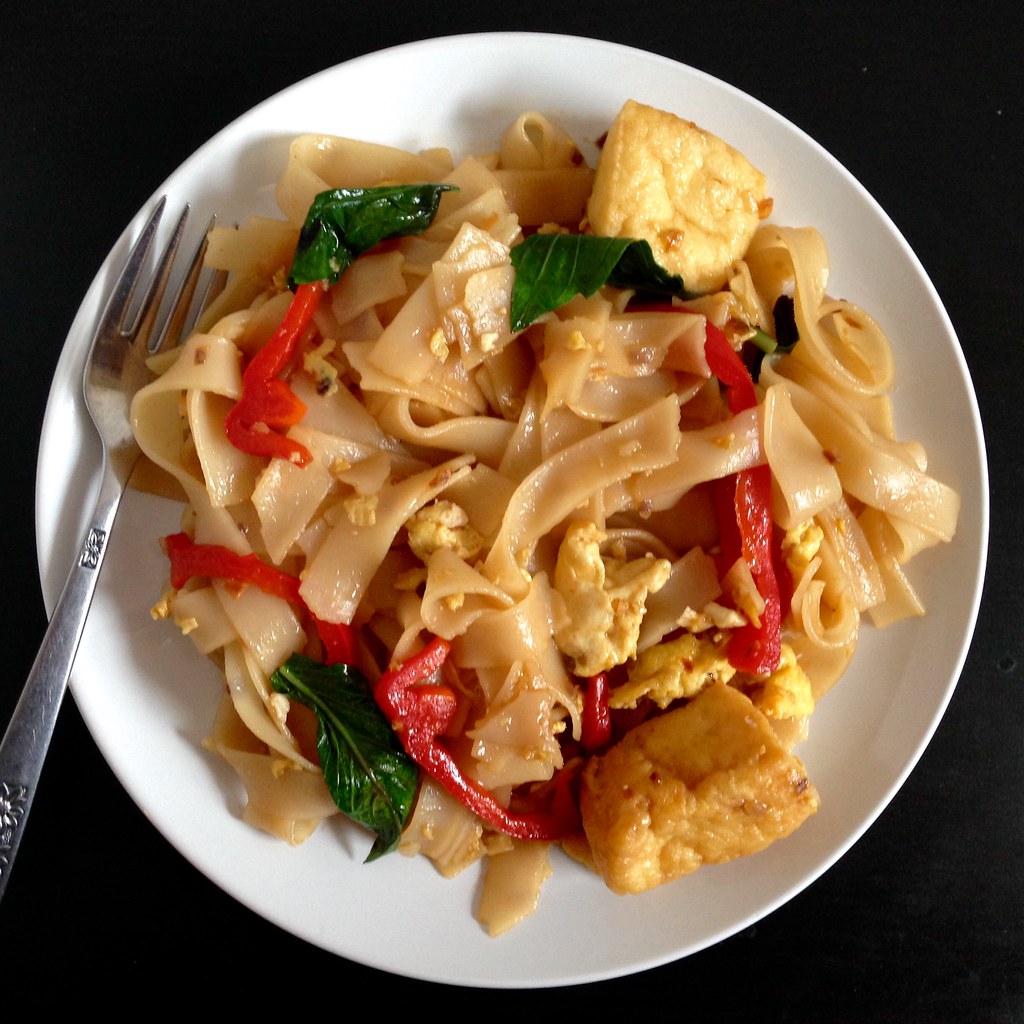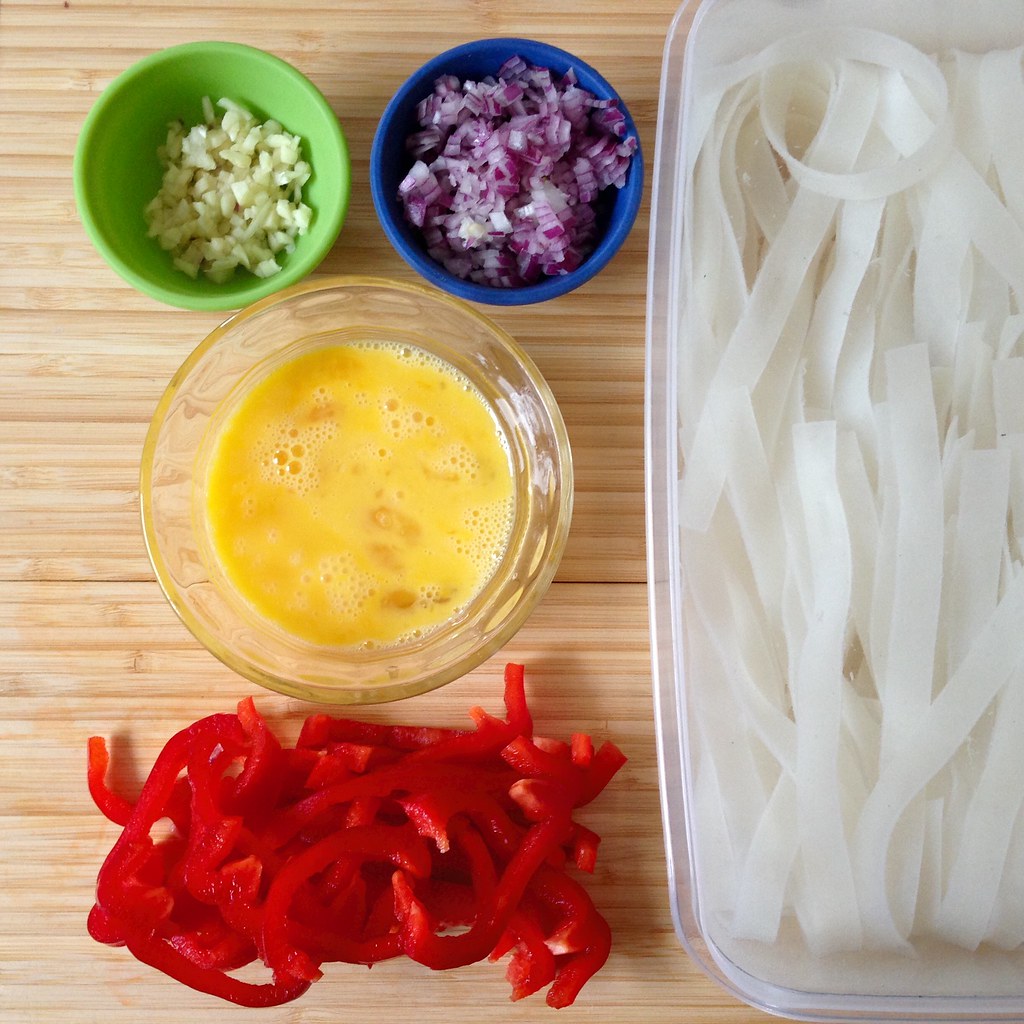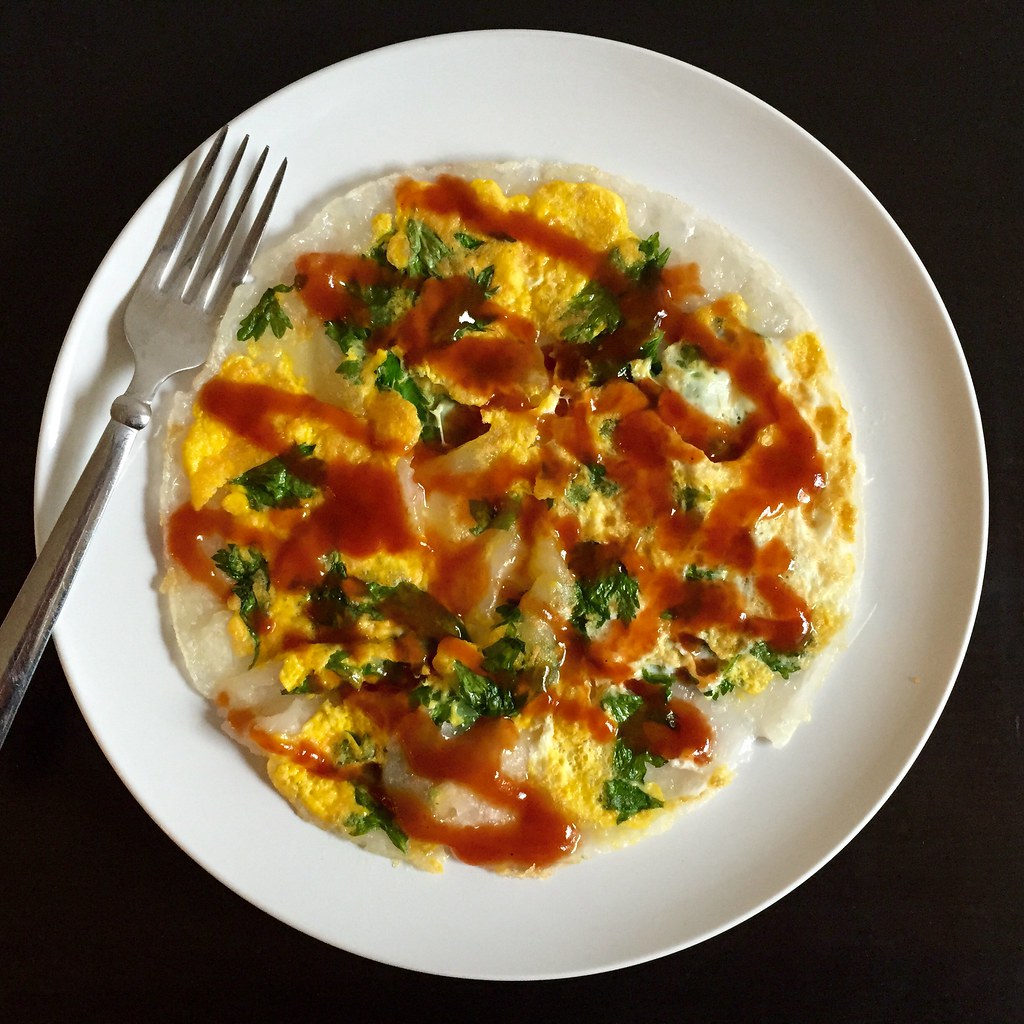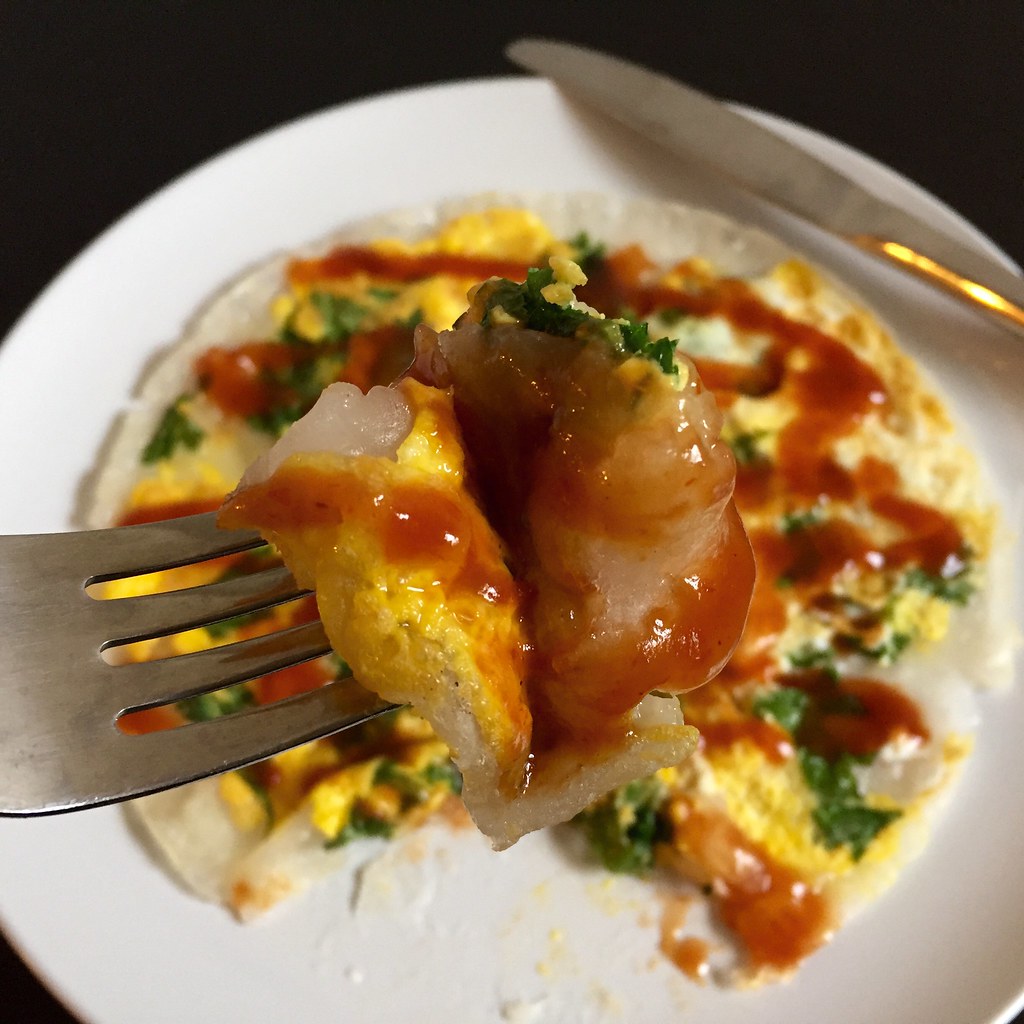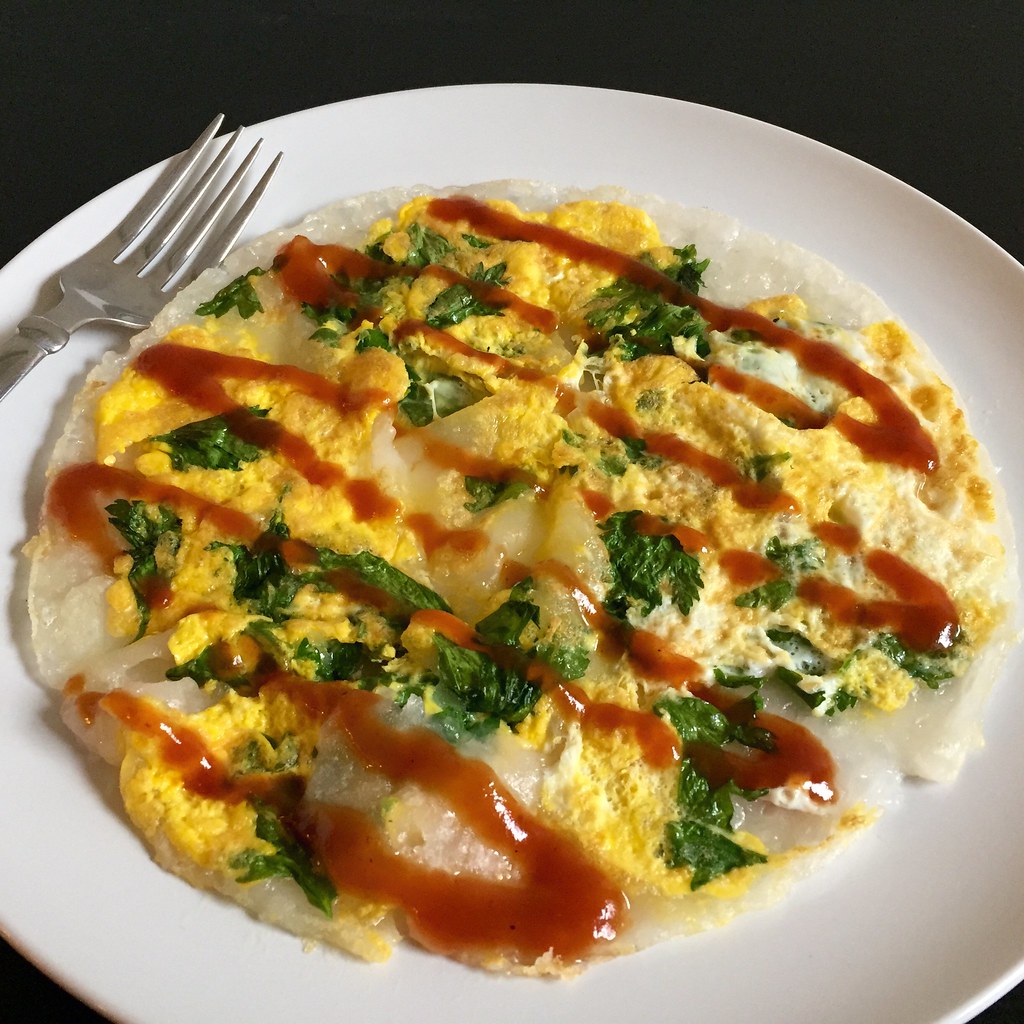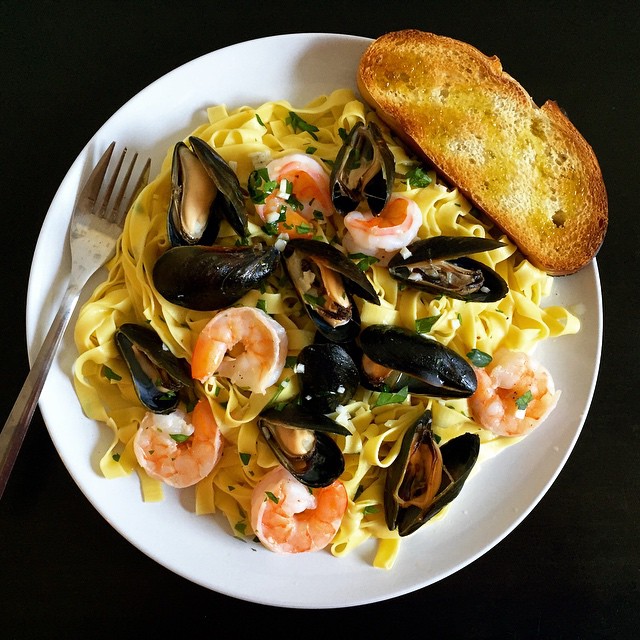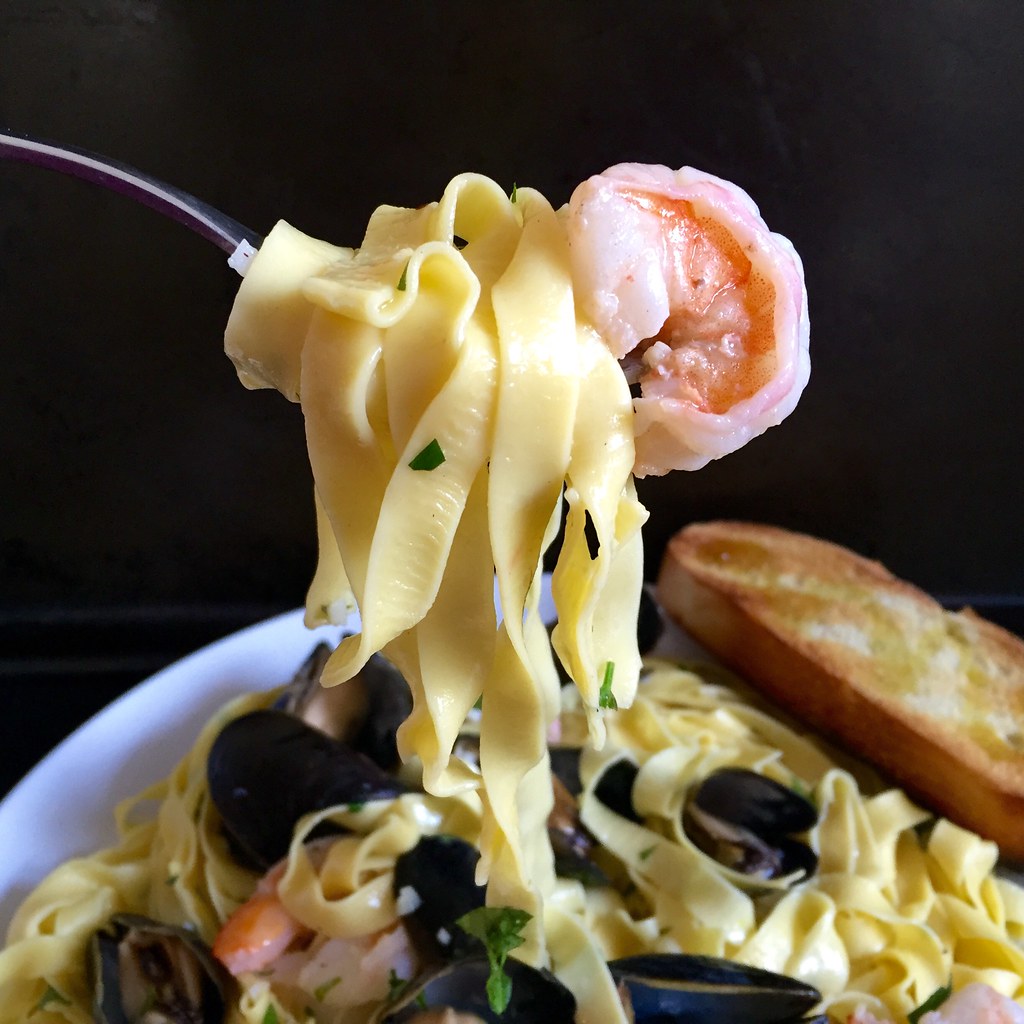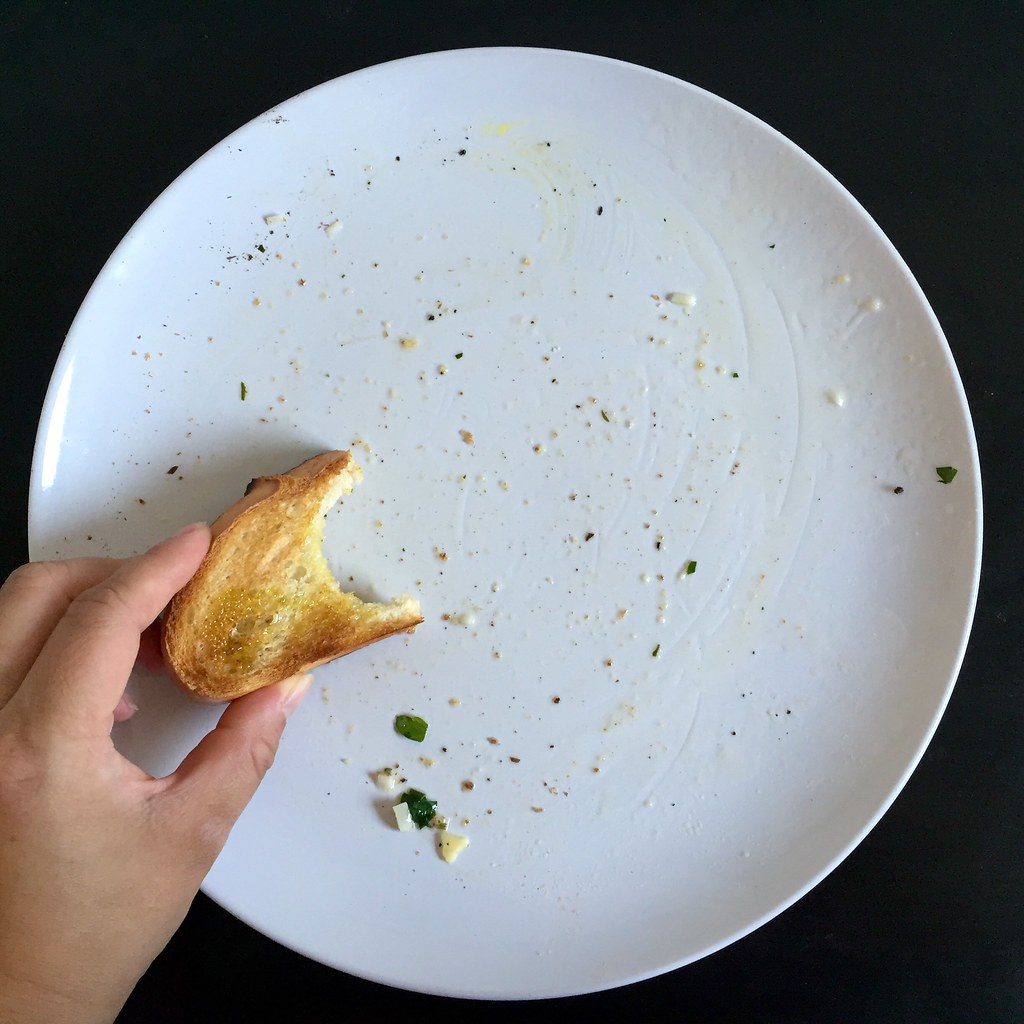Wednesday, May 20, 2015
Drunken Noodles (Pad Kee Mao) with Tofu
When I go to a Thai restaurant I usually order pad see ew or pad woon sen, but every once in a while I'm in the mood for something a little spicier, and for that I turn to drunken noodles, or pad kee mao. According to the menu at my favorite Thai restaurant, Pepper Sky's, drunken noodles were "originally stir-fried by a singing drunkard to starve [sic] off midnight hunger. Ingredients previously thought to be incompatible were tossed into the wok, and voila[!] Drunken noodle."
Sadly, Pepper Sky's is currently closed for renovations, so I decided to try making the dish myself. I pretty much followed this recipe from Food52 except I added some sugar to the sauce since I prefer my drunken noodles slightly sweet. I also increased the amount of egg since I wasn't adding any shrimp. I wasn't able to find rice flake noodles, so I used the widest rice noodles I could find. If you can find fresh wide rice noodles, I would suggest using those and skipping the soaking step.
This is one of those recipes where you want to make sure you have all the vegetables minced and chopped before you start cooking since it comes together pretty quickly. Feel free to add other vegetables; I'm used to seeing tomato slices, baby corn, bamboo shoots, carrots, string beans, and zucchini in the drunken noodles I get at Thai restaurants.
Drunken Noodles (Pad Kee Mao) with Tofu (adapted from Lollipopsicle by way of Food52)
serves 3
7 oz. wide rice stick noodles
2 tablespoons hoisin or soy paste (if using soy paste, add a teaspoon of sugar)
2 tablespoons soy sauce
1 tablespoon oyster sauce
1-3 teaspoons sriracha, depending on how hot you want it
2 tablespoons fish sauce
3 tablespoons vegetable oil
3 garlic cloves, minced
1 shallot or 1/2 red onion, minced
3 eggs, lightly beaten
5 oz. fried tofu
1 red bell pepper, diced
A large handful of Thai basil leaves
Place the rice stick noodles in a wide container and pour enough boiling water over the noodles to cover them by an inch. Stir the noodles periodically so that they don't stick together. Check them after 10 minutes to see if they are pliable and continue to soak until they are. You may have to add additional hot water. When the rice noodles are pliable but not mushy, drain. Try to time this so that the noodles are ready just in time to be added to the skillet.
Mix together the hoisin (or soy paste and sugar), soy sauce, oyster sauce, sriracha, and fish sauce in a small bowl.
Heat a large skillet over medium high heat and add the vegetable oil. Add the minced garlic and shallot and stir fry until golden brown. Move the garlic and shallots to the sides of the pan and add the eggs to the middle. Scramble the eggs until just set and add the fried tofu, sliced bell pepper, and any other vegetables you might be using. Stir fry for a couple of minutes, then add the drained noodles and the sauce. Stir fry for 5 minutes, then add the basil and cook for another couple of minutes until some of the noodles are starting to get brown and crispy. Serve hot.
Next: Tofu Tikka Masala
Previously: Taiwanese Oyster Omelet (Without the Oysters)
Six Years Ago: Zuni Cafe Ricotta Gnocchi with Browned Butter and Sage
Monday, May 18, 2015
Taiwanese Oyster Omelet (Without the Oysters)
I know, I know, it's almost blasphemy to make 蚵仔煎 (pronounced "uh-ah-jian" in Taiwanese) without the oysters, but honestly, the oysters are my least favorite part of this dish. I love the blend of crispy and gelatinous textures from the sweet potato flour batter, the fried egg that holds it all together, and the tangy red sauce that smothers it all, but the chewy, cooked oysters just get in my way.
For this recipe I combined the omelet from Tiny Urban Kitchen and the red sauce from Serious Eats. The sauce was so spot on that when I took my first bite, I totally thought I tasted an oyster in there and was pleasantly confused. If you want to make this with oysters, use 3-4 small, shucked oysters for each pancake and either add them to the hot pan before the batter for a minute or two or mix them in with the batter before cooking, depending on how cooked you want them.
As a word of caution, the batter made from sweet potato flour (which you should be able to find at an Asian grocery store) will be one of the stickiest things you've ever worked with once it starts cooking. Make sure you use a non-stick or thoroughly seasoned pan, and even then, I would suggest using a generous amount of oil to make sure it doesn't stick.
Taiwanese Oyster Omelet (Without the Oysters) (adapted from Tiny Urban Kitchen and Serious Eats)
makes 1 omelet
For the red sauce (makes enough for several omelets):
1/4 cup ketchup
1/4 cup rice vinegar
1 tablespoon sugar
1 tablespoon soy sauce
1/2 teaspoon miso
1 1/2 teaspoons cornstarch
1/2 cup cold water
For the omelet:
1/4 cup sweet potato flour
Pinch of kosher salt
Dash of white pepper
1/2 cup water
Vegetable oil
A small handful of celery leaves (or other leafy greens like baby spinach or bok choy)
1 egg, lightly beaten
To make the sauce, combine the ketchup, vinegar, sugar, soy sauce, and miso in a small saucepan over medium heat. Simmer for a couple of minutes until the sugar dissolves.
Mix the cornstarch and water to make a slurry and add to the saucepan. Stir until thickened, another couple of minutes, and then cool to room temperature.
To make the omelet, mix the sweet potato flour, salt, white pepper, and water into a smooth batter. Heat a non-stick or thoroughly seasoned pan over high heat. Add enough oil to cover the bottom of the pan generously, not enough to deep fry but enough that there is a visible layer of oil all over.
Pour the batter into the pan, and lower the heat to medium. Once the top of the batter is set, add the leaves, continue to cook for another minute, and then add the egg. Use a spatula to start testing the edge of the omelet to see if the bottom is cooked and releasing from the pan. When the bottom has released and the egg is mostly set, flip the omelet over and turn off the heat. The residual heat from the pan should be enough to finish cooking the egg.
Invert the omelet onto a plate and drizzle a generous amount of red sauce on top. Serve hot.
It's kind of freakish how intact my omelets ended up; I'm used to them being pretty mangled blobs of gelatinous messes. In fact, the picture above was a little too perfect so I ended up drizzling more sauce on top just to make it messier, which is how I ended up with the top picture. It's also more representative of how much sauce you want on the omelet.
Next: Drunken Noodles (Pad Kee Mao) with Tofu
Previously: Scoglio all'Andiamo (Saffron Fettuccine with Seafood in a Lemon Garlic White Wine Sauce)
Last Year: Serendipitous Chocolate Chip Cookies
Six Years Ago: Red Bean and Black Sesame Ice Cream
Monday, May 11, 2015
Scoglio all'Andiamo (Saffron Fettuccine with Seafood in a Lemon Garlic White Wine Sauce)
Last year I was lucky enough to win two nights at a Marriott resort of my choosing in the Caribbean through an Instagram contest. At first I considered going to St. Kitts & Nevis since I had never been before, but the airfare was outrageous, so I ended up choosing to go back to Grand Cayman. I used my points to stay an extra two nights at the Ritz Carlton and brought along two girlfriends.
I was sad to find out that the Periwinkle restaurant at the Ritz was gone because I had the best truffle fries of my life there a few years ago, but when I found out that the Italian restaurant that had replaced it, Andiamo, had the truffle parmesan fries on their menu, I insisted that we go there for our last dinner on the island.
The fries were as good--if not better--than I remember them being, but I was also really impressed with their version of pasta allo scoglio, also known as pasta ai frutti di mare. Scoglio means "rocky seashore" in Italian, and all types of seafood can be used in this dish. Shrimp and mussels were on sale, so that's what I used, but clams, scallops, and calamari would also work.
Unlike most recipes for pasta allo scoglio, there were no tomatoes in Andiamo's version; all I tasted was a clean white wine sauce with garlic and lemons spiked with the delicious juices from the clams and mussels. The sauce was so good we asked for another basket of bread just so we could soak it all up. The pasta they used was a saffron fettuccine, which I attempted to make from scratch. Since I didn't have any saffron on hand, I added some saffron salt to the fresh pasta dough and finished the dish with more saffron salt. If I were to make this again, I'd probably add a pinch of turmeric to the pasta dough to bring out the bright yellow coloring more.
Scoglio all'Andiamo (Saffron Fettuccine with Seafood in a Lemon Garlic White Wine Sauce)
serves 2-3
1/4 cup butter
2 garlic cloves, minced
2/3 cup dry white wine
1 lb. mussels and/or clams
1 lb. peeled raw shrimp and/or scallops
1/2 lb. dried fettuccine or 3/4 lb. fresh fettuccine
Juice from 1/2 a lemon
1 tablespoon chopped parsley (optional)
Saffron salt (if you have it, if not, regular sea salt is fine)
Freshly ground pepper
Lemon slices
Bring a pot of salted water to boil. Cook the fettuccine to al dente (if using fresh pasta, wait until the after adding the shrimp to the pan to start cooking the pasta).
In the meantime, melt the butter over medium-low heat in a large skillet. Add the garlic cloves and saute for a minute. Add the white wine and the mussels and/or clams. Cover and let steam until the shellfish have opened. Use a slotted spoon to remove the shellfish from the skillet and set aside in a bowl.
Add the shrimp and/or scallops and cook until just opaque. Add the cooked pasta, lemon juice, parsley, and shellfish back to the skillet and toss well. Season with salt and pepper to taste. Serve immediately with lemon slices and crusty bread to soak up any leftover sauce.
Next: Taiwanese Oyster Omelet (Without the Oysters)
Previously: Gordon Ramsay's Sublime Scrambled Eggs - Two Ways
Last Year: Candied Bacon Chocolate Chip Pancakes
Five Years Ago: Passion Fruit Ice Cream
Six Years Ago: Carrot Cake Ice Cream
Subscribe to:
Comments (Atom)
